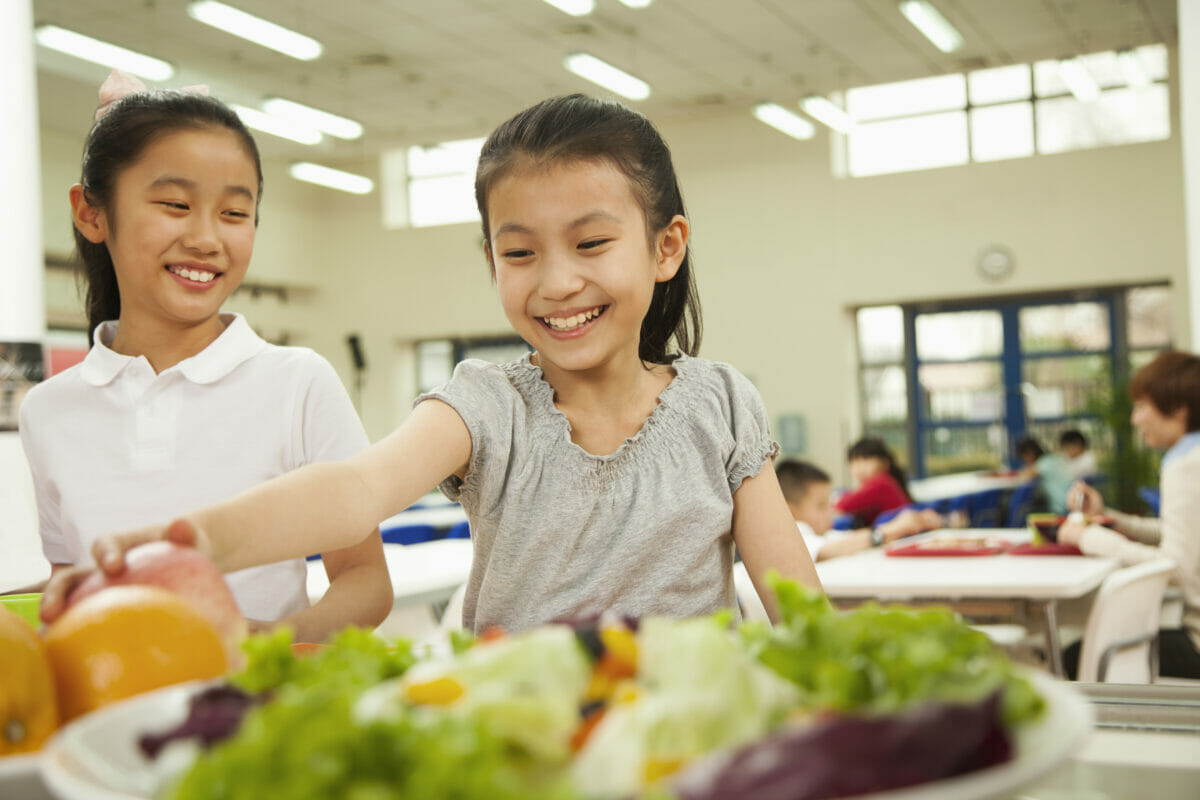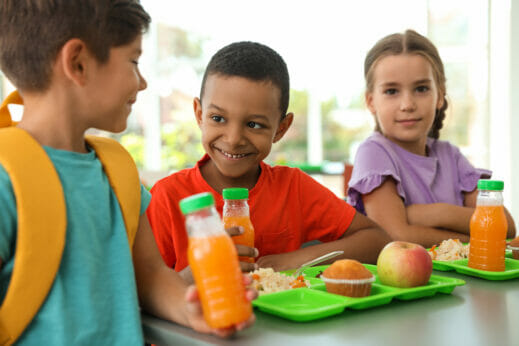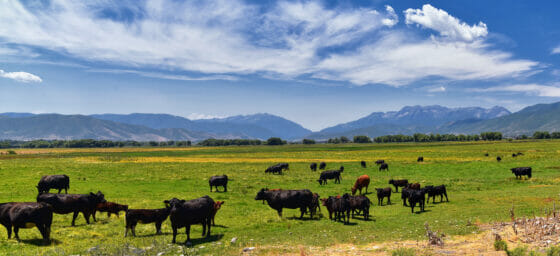Local Food Purchasing Incentives are state programs that reimburse schools for buying locally. But first, states need to define what’s “local.”

In Utah, kids moving through the school cafeteria line at lunchtime can come across the Elliott apple, a yellow-gold fruit with a light blush of red. Discovered in-state and hard to get elsewhere, it’s a uniquely Utah product.
“It’s really fun when schools buy those apples and the kids get to learn about it,” says Kate Wheeler, Farm to Fork specialist for the Utah State Board of Education.
Elliott apples end up in state school lunches thanks to farm-to-school programs, initiatives that have expanded in the last few decades as a way to support children’s nutrition and regional agriculture. And it’s not just in Utah. With schools back in session, many school districts will be putting food from local farms on kids’ lunch trays. Farm-to-school programs can manifest in many different ways, but one pathway that has been increasingly adopted in recent years is Local Food Purchasing Incentives (LFPIs).
LFPIs are state-led programs allowing schools or early care programs to receive financial reimbursement for buying food from local producers. Buying local can be cost-prohibitive, so these types of programs are on the rise after calls for institutional support through state policy. Between 2001 and 2019, eight states and Washington, D.C. established programs across the country. Since the onset of the pandemic, seven additional states have adopted LFPI programs. These initiatives aim to increase local food purchasing for school meals, while providing children with nutritious food, strengthening local economies and helping school districts overcome cost barriers to local food.
No two of these programs are identical. But a question they all have to answer is what does “local” food mean, anyway?
Bespoke programs for states
In New York, School Food Authorities (nonprofits in charge of cafeterias) that spend 30 percent of their lunch budget on in-state food get an extra $0.19 cents back for every reimbursable lunch. Maine’s Local Foods Fund reimburses school districts with a dollar for every $3 spent on select local food, with a $5,000 cap for the school year—$5,500 if schools participate in a local foods training. Maine’s program began in 2001, but it received bolstered funding in 2019 and has been expanding and adjusting since then.
Some farm-to-school programs include farm education for students. (Photo: Shutterstock)
“It’s a constant evolution,” Robin Kerber, implementation manager for Full Plates Full Potential, an organization addressing food insecurity for children in Maine, said in a recent webinar hosted by the National Farm to School Network and Michigan State University’s Center for Regional Food Systems. “Every year, we’re reassessing what’s working, what’s not working, because we want it to work for everybody.”
This growing tide of LFPIs includes overlaps with other farm-to-school initiatives. One program distributes USDA funds to states to buy local food for schools. Additionally, some states are embracing a universal school meal model, wherein all kids eat for free at school, regardless of family income. Some of these include incentives for local food purchasing. This fall, students in Minnesota are experiencing the results of a universal meal policy for the first time.
“If there’s anything I can share, it’s that each incentive program is uniquely designed and administered,” says Cassandra Bull, policy consultant and host of the webinar series.
What is “local” food?
In practice, “local” is hard to define. Utah, for example, considers local to be anything Utah-grown. Wheeler says this approach isn’t without nuance. For example, schools can be reimbursed for Utah-made sour cream and cheese, but in the processing plants, milk from across state lines gets blended together to make these products. Utah counts these products as local as long as the product is made with 50 percent Utah-sourced milk.
“The other piece that we’ve struggled with a little bit is, is local a value in and of itself?” says Wheeler. “Or do we want to be promoting specific types of values-based procurements where we’re looking at how the food is produced and how it’s grown and worker treatment and all of those other values that sometimes we associate with “local” but aren’t necessarily inherently part of just buying something that’s close to you.”
But while big western states can equate “local” with “in-state,” things get trickier in the smaller states. New Hampshire is currently in the process of trying to pass a bill to support an LFPI. But only seven percent of New Hampshire is agricultural land, and many of the farms that it does have are dedicated to growing trees or hay.

Three children having lunch. (Photo: Shutterstock)
Eight of New Hampshire’s 10 counties border other states or Canada, and Stacey Purslow, program coordinator for the New Hampshire Farm to School Program within the University of New Hampshire Sustainability Institute, says three of their school districts have students that live in one state and go to school in another. What this means is that the definition of “local” is going to be different than “from New Hampshire.”
“We don’t grow that much here, and we have cross-state school districts,” says Purslow. “So, we wanted to support New England agriculture as well.”
Conor Floyd, grant programs manager for Child Nutrition Programs in the Vermont Agency of Education, acknowledges that defining local food is not cut and dry.
“One really thorny issue for us in our process was, what counts as local?” says Floyd. Vermont uses a definition created by the state legislature. Beyond having a succinct definition, there’s also the matter of enforcement. “The question for me was, who’s checking to make sure that this is local or not?”
Tracking local purchases
In order to be compensated, schools need to keep track of local purchases. This can be tedious, but it can provide an accurate picture of local procurement in the state and show farmers what schools are buying.
In Utah, schools have a tracking spreadsheet to use throughout the year. If they don’t keep track along the way, it can result in confusion and difficulty when it comes time to submit, says Wheeler.
“Some of our folks who are buying local are also not submitting for reimbursement because they feel like it’s too much work,” says Wheeler.
Harvest New York, an organization that helps grow the farm and food economy in New York state, created a database to help School Food Authorities track down qualifying products and get the paperwork they need.
“We need to make sure that the products are actually from New York, but the paperwork can’t be so onerous that our school food authorities don’t want to participate in it,” says Cheryl Bilinksi, local food systems specialist and Farm to School lead at Harvest New York.

Cows in a field in Utah. (Photo: Shutterstock)
For Wheeler, the success stories keep her going. New this year, Utah have established cooperative contracts with seven ranchers across the state. Every school in the state can order and be reimbursed funds for local beef or bison.
“The ranchers are so excited, and the schools are so excited,” says Wheeler. “Just seeing something work makes you realize it can continue to work, and that’s definitely one of the things that keeps you going.”
An admirable effort. One problem however, at least in the Northern half of the country is: When are kids in school?: September – June. When do farmers harvest produce?: June-September. There is a seasonality problem at least for fruits and vegetables.
Great way to teach students about meaningless gestures.